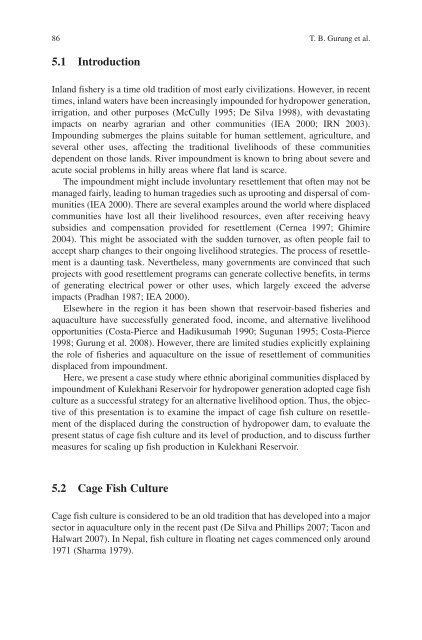Success Stories In Asian Aquaculture - Library - Network of ...
Success Stories In Asian Aquaculture - Library - Network of ...
Success Stories In Asian Aquaculture - Library - Network of ...
- No tags were found...
You also want an ePaper? Increase the reach of your titles
YUMPU automatically turns print PDFs into web optimized ePapers that Google loves.
86 T. B. Gurung et al.5.1 <strong>In</strong>troduction<strong>In</strong>land fishery is a time old tradition <strong>of</strong> most early civilizations. However, in recenttimes, inland waters have been increasingly impounded for hydropower generation,irrigation, and other purposes (McCully 1995 ; De Silva 1998 ), with devastatingimpacts on nearby agrarian and other communities (IEA 2000 ; IRN 2003) .Impounding submerges the plains suitable for human settlement, agriculture, andseveral other uses, affecting the traditional livelihoods <strong>of</strong> these communitiesdependent on those lands. River impoundment is known to bring about severe andacute social problems in hilly areas where flat land is scarce.The impoundment might include involuntary resettlement that <strong>of</strong>ten may not bemanaged fairly, leading to human tragedies such as uprooting and dispersal <strong>of</strong> communities(IEA 2000) . There are several examples around the world where displacedcommunities have lost all their livelihood resources, even after receiving heavysubsidies and compensation provided for resettlement (Cernea 1997 ; Ghimire2004) . This might be associated with the sudden turnover, as <strong>of</strong>ten people fail toaccept sharp changes to their ongoing livelihood strategies. The process <strong>of</strong> resettlementis a daunting task. Nevertheless, many governments are convinced that suchprojects with good resettlement programs can generate collective benefits, in terms<strong>of</strong> generating electrical power or other uses, which largely exceed the adverseimpacts (Pradhan 1987 ; IEA 2000) .Elsewhere in the region it has been shown that reservoir-based fisheries andaquaculture have successfully generated food, income, and alternative livelihoodopportunities (Costa-Pierce and Hadikusumah 1990 ; Sugunan 1995 ; Costa-Pierce1998 ; Gurung et al. 2008) . However, there are limited studies explicitly explainingthe role <strong>of</strong> fisheries and aquaculture on the issue <strong>of</strong> resettlement <strong>of</strong> communitiesdisplaced from impoundment.Here, we present a case study where ethnic aboriginal communities displaced byimpoundment <strong>of</strong> Kulekhani Reservoir for hydropower generation adopted cage fishculture as a successful strategy for an alternative livelihood option. Thus, the objective<strong>of</strong> this presentation is to examine the impact <strong>of</strong> cage fish culture on resettlement<strong>of</strong> the displaced during the construction <strong>of</strong> hydropower dam, to evaluate thepresent status <strong>of</strong> cage fish culture and its level <strong>of</strong> production, and to discuss furthermeasures for scaling up fish production in Kulekhani Reservoir.5.2 Cage Fish CultureCage fish culture is considered to be an old tradition that has developed into a majorsector in aquaculture only in the recent past (De Silva and Phillips 2007 ; Tacon andHalwart 2007) . <strong>In</strong> Nepal, fish culture in floating net cages commenced only around1971 (Sharma 1979) .
















